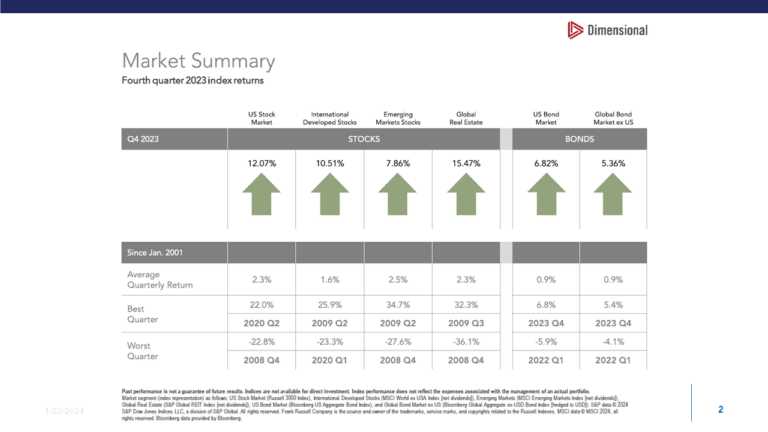In Part II of our three-part series on the Tax Cuts and Jobs Act (Part I of our series can be found here), we shift our focus to strategies you can deploy before the end of the year to maximize tax efficiency. As always, you should consult with your tax professional or financial advisor before making any changes to your financial plans.
The basis for taking action revolves around four simple principles:
- Most people will have a lower marginal tax rate next year.
- Most people will pay less tax overall next year.
- Some people who itemize now will not be able to itemize next year.
- Some people will still itemize next year, but those deductions are unlikely to be substantially more than the new standard deduction.
1. Accelerate Charitable Giving Before 2018
If you plan to itemize in 2017, and do not believe you will be able to itemize in 2018, then you should consider accelerating your charitable gifts and donations this year. Gifts given in 2017 will result in tax savings, if you itemize, while gifts given in 2018, for those using the standard deduction, will not. You should also consider donating more to charity in 2017, even if you expect to itemize in 2018, especially if your marginal tax bracket drops substantially in the New Year. The tax deduction this year could be worth a lot more than next.
2. Consider Prepaying 2018 Local Property Taxes
If you itemize in 2017, then consider prepaying your 2018 local property taxes, especially if you already pay more than $10,000 per year in state income taxes. The new tax bill does not allow a deduction for prepayment of state income tax, but allows it for local property taxes!
Prepayment is even more important if you believe you will no longer be able to itemize deductions in 2018, because of changes in the standard deduction. Important Note: If you are in the Alternative Minimum Tax (AMT) for 2017, this strategy is not likely to result in much tax savings, if any, since the AMT rules do not allow deductions for state income or property taxes.
3. Prepay your January 2018 Mortgage Payment
If you plan to itemize in 2017, but do not expect to in 2018, then consider pre-paying your January 2018 mortgage payment by December 31. The interest will be deductible on your 2017 return.
4. Prepay Estimated Tax Payments
If you pay quarterly estimated tax payments and are scheduled to make your fourth quarter 2017 payment in January 2018, consider making the payment in 2017 if you itemize, especially if you will not itemize in 2018, or if your marginal tax rate is going down next year. The new tax bill places a $10,000 combined cap on individual deductions for these payments. Note, however, that the law strictly prohibits your ability to prepay any 2018 state income taxes in 2017. As noted before, if you are in the Alternative Minimum Tax (AMT) for 2017, this strategy is not likely to result in much tax savings, if any, since the AMT rules do not allow deductions for state income or property taxes.
5. Contribute to a Traditional IRA
Contributing now to a traditional IRA will allow you take the tax deduction for 2017 while your marginal tax rate may be higher. This will result in a tax deduction this year and potentially tax savings in the future, if, eventually, withdrawals are taken at lower tax rates in retirement.
6. Pay Outstanding Medical bills
Consider paying all outstanding medical bills by the end of 2017 if you intend to itemize this year and have enough medical expenses (greater than 7.5% of adjusted gross income**) to claim the deduction. While the medical expense deduction remains in the new tax law, if you cannot itemize next year, bills paid in January will not reduce your tax bill. Even if you can itemize next year and deduct the medical expenses, if your marginal tax rate is higher in 2017 than 2018, it will result in tax savings, provided that you pay these expenses this year instead of next.
**The new tax bill keeps the medical expense deduction, but also provides a retroactive 7.5% AGI threshold, meaning that even your 2017 expenses are deductible once you reach that threshold (previously 10% of AGI). The reduced AGI floor continues through 2018, after which it returns to 10% permanently.
7. Sell Investments with Losses
Sell investments that have capital losses now to offset this year’s gains, and potentially, ordinary income up to $3,000 in 2017. The tax loss could be worth more to you this year than next.
8. Delay Selling Stocks with Large Capital Gains
You may want to delay selling stock that will result in large capital gains, if ultimately that sale will result in your other sources of income, like Social Security, becoming taxable in 2017. Instead, consider selling stock in 2018, when the marginal tax rate on your ordinary income is likely to be lower.
It is important that you review your tax situation with a professional before taking any action. A good place to start is to review last year’s income tax return and then consult your financial advisor or tax preparer on what the new law could mean for you. In Part III of our continuing series on tax reform (due out just after Christmas), we will explore some hypothetical scenarios for tax filers, drawing comparisons between existing law and the new legislation. We will also provide useful links to tax calculators and resources to help you navigate your tax decision-making process!


